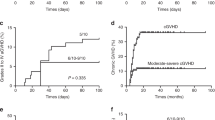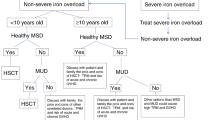Summary:
Shwachman-Diamond syndrome (SDS) is an autosomal recessive disorder characterized by pancreatic insufficiency and variable degrees of neutropenia. SDS patients are at risk of developing myelodysplasia, aplastic anemia, and leukemic transformation. The role and timing of allogeneic hematopoietic stem cell transplantation (HSCT) in SDS remain controversial. We report three SDS patients with severe aplasia transplanted using unrelated umbilical cord blood (UCB). Patients received melphalan (180 mg/m2), etoposide (1200 mg/m2), anti-thymocyte globulin (90 mg/kg), and total lymphoid irradiation (500 cGy); graft-versus-host disease (GVHD) prophylaxis consisted of cyclosporine and prednisone. Myeloid engraftment occurred promptly with absolute neutrophil count >500 cells/mm3 on day 15±5 and all patients displayed 100% donor chimerism by 2 months post transplant. The major complication of transplant was GVHD, with all patients developing grade II or III acute GVHD, one progressing to chronic extensive GVHD. Patients are alive 309, 623, and 2029 days post transplant. Factors important in HSCT outcome for SDS may include transplantation at a young age, avoidance of cyclophosphamide, and adequate GVHD prophylaxis. Importantly, these cases also suggest that unrelated UCB, in the absence of a matched family member, is an excellent alternative stem cell source for SDS patients undergoing HSCT.
This is a preview of subscription content, access via your institution
Access options
Subscribe to this journal
Receive 12 print issues and online access
$259.00 per year
only $21.58 per issue
Buy this article
- Purchase on Springer Link
- Instant access to full article PDF
Prices may be subject to local taxes which are calculated during checkout

Similar content being viewed by others
References
Dror Y, Freedman MH . Shwachman-Diamond Syndrome. Br J Haematol 2002; 118: 701–713.
Ginzberg H, Shin J, Ellis L et al. Shwachman syndrome: phenotypic manifestations of sibling sets and isolated cases in a large patient cohort are similar. J Pediatr 1999; 135: 81–88.
Stepanovic V, Wessels D, Goldman FD et al. The chemotaxis defect of Shwachman-Diamond Syndrome leukocytes. Cell Motil Cytoskeleton 2004; 57: 158–174.
Smith OP, Hann IM, Chessells JM et al. Haematological abnormalities in Shwachman-Diamond syndrome. Br J Haematol 1996; 94: 279–284.
Boocock GR, Morrison JA, Popovic M et al. Mutations in SBDS are associated with Shwachman-Diamond syndrome. Nat Genet 2003; 33: 97–101.
Savchenko A, Krogan N, Cort JR et al. The Shwachman-Bodian-Diamond syndrome protein family is involved in RNA metabolism. J Biol Chem 2005; 280: 19213–19220.
Shammas C, Menne TF, Hilcenko C et al. Structural and mutational analysis of the SBDS protein family. Insight into the leukemia-associated Shwachman-Diamond Syndrome. J Biol Chem 2005; 280: 19221–19229.
Makitie O, Ellis L, Durie PR et al. Skeletal phenotype in patients with Shwachman-Diamond syndrome and mutations in SBDS. Clin Genet 2004; 65: 101–112.
Kuijpers TW, Alders M, Tool AT et al. Hematologic abnormalities in Shwachman Diamond syndrome: lack of genotype–phenotype relationship. Blood 2005; 106: 356–361.
Rothbaum R, Perrault J, Vlachos A et al. Shwachman-Diamond syndrome: report from an international conference. J Pediatr 2002; 141: 266–270.
Lesesve JF, Dugue F, Gregoire MJ et al. Shwachman-Diamond syndrome with late-onset neutropenia and fatal acute myeloid leukaemia without maturation: a case report. Eur J Haematol 2003; 71: 393–395.
Mitsui T, Kawakami T, Sendo D et al. Successful unrelated donor bone marrow transplantation for Shwachman-Diamond syndrome with leukemia. Int J Hematol 2004; 79: 189–192.
Fleitz J, Rumelhart S, Goldman F et al. Successful allogeneic hematopoietic stem cell transplantation (HSCT) for Shwachman-Diamond syndrome. Bone Marrow Transplant 2002; 29: 75–79.
Styczynski J, Cheung YK, Garvin J et al. Outcomes of unrelated cord blood transplantation in pediatric recipients. Bone Marrow Transplant 2004; 34: 129–136.
Wagner JE, Barker JN, DeFor TE et al. Transplantation of unrelated donor umbilical cord blood in 102 patients with malignant and nonmalignant diseases: influence of CD34 cell dose and HLA disparity on treatment-related mortality and survival. Blood 2002; 100: 1611–1618.
Grewal SS, Barker JN, Davies SM, Wagner JE . Unrelated donor hematopoietic cell transplantation: marrow or umbilical cord blood? Blood 2003; 101: 4233–4244.
Laughlin MJ, Eapen M, Rubinstein P et al. Outcomes after transplantation of cord blood or bone marrow from unrelated donors in adults with leukemia. N Engl J Med 2004; 351: 2265–2275.
Glucksberg H, Storb R, Fefer A et al. Clinical manifestations of graft-versus-host disease in human recipients of marrow from HL-A-matched sibling donors. Transplantation 1974; 18: 295–304.
Shwachman H, Diamond LK, Oski FA, Khaw KT . The syndrome of pancreatic insufficiency and bone marrow dysfunction. J Pediatr 1964; 65: 645–663.
Bagby GC, Lipton JM, Sloand EM, Schiffer CA . Marrow failure. Hematology (Am Soc Hematol Educ Program) 2004, 318–336.
Heaney ML, Golde DW . Myelodysplasia. N Engl J Med 1999; 340: 1649–1660.
Donadieu J, Leblanc T, Bader Meunier B et al. Analysis of risk factors for myelodysplasias, leukemias and death from infection among patients with congenital neutropenia. Experience of the French Severe Chronic Neutropenia Study Group. Haematologica 2005; 90: 45–53.
Raj AB, Bertolone SJ, Barch MJ, Hersh JH . Chromosome 20q deletion and progression to monosomy 7 in a patient with Shwachman-Diamond syndrome without MDS/AML. J Pediatr Hematol Oncol 2003; 25: 508–509.
Sokolic RA, Ferguson W, Mark HF . Discordant detection of monosomy 7 by GTG-banding and FISH in a patient with Shwachman-Diamond syndrome without evidence of myelodysplastic syndrome or acute myelogenous leukemia. Cancer Genet Cytogenet 1999; 115: 106–113.
Park SY, Chae MB, Kwack YG et al. Allogeneic bone marrow transplantation in Shwachman-Diamond syndrome with malignant myeloid transformation. A case report. Korean J Intern Med 2002; 17: 204–206.
Hsu JW, Vogelsang G, Jones RJ, Brodsky RA . Bone marrow transplantation in Shwachman-Diamond syndrome. Bone Marrow Transplant 2002; 30: 255–258.
Cunningham J, Sales M, Pearce A et al. Does isochromosome 7q mandate bone marrow transplant in children with Shwachman-Diamond syndrome? Br J Haematol 2002; 119: 1062–1069.
Tsai PH, Sahdev I, Herry A, Lipton JM . Fatal cyclophosphamide-induced congestive heart failure in a 10-year-old boy with Shwachman-Diamond syndrome and severe bone marrow failure treated with allogeneic bone marrow transplantation. Am J Pediatr Hematol Oncol 1990; 12: 472–476.
Faber J, Lauener R, Wick F et al. Shwachman-Diamond syndrome: early bone marrow transplantation in a high risk patient and new clues to pathogenesis. Eur J Pediatr 1999; 158: 995–1000.
Cesaro S, Guariso G, Calore E et al. Successful unrelated bone marrow transplantation for Shwachman-Diamond syndrome. Bone Marrow Transplant 2001; 27: 97–99.
Ballen KK . New trends in umbilical cord blood transplantation. Blood 2005; 105: 3786–3792.
Acknowledgements
We thank the patients and families that participated in this study and the medical staff that cared for these patients.
Author information
Authors and Affiliations
Corresponding author
Rights and permissions
About this article
Cite this article
Vibhakar, R., Radhi, M., Rumelhart, S. et al. Successful unrelated umbilical cord blood transplantation in children with Shwachman-Diamond syndrome. Bone Marrow Transplant 36, 855–861 (2005). https://doi.org/10.1038/sj.bmt.1705142
Received:
Accepted:
Published:
Issue Date:
DOI: https://doi.org/10.1038/sj.bmt.1705142
Keywords
This article is cited by
-
Long-term outcome after allogeneic hematopoietic stem cell transplantation for Shwachman–Diamond syndrome: a retrospective analysis and a review of the literature by the Severe Aplastic Anemia Working Party of the European Society for Blood and Marrow Transplantation (SAAWP-EBMT)
Bone Marrow Transplantation (2020)
-
Increased sensitivity for detecting malaria parasites in human umbilical cord blood using scaled-up DNA preparation
Malaria Journal (2012)
-
High-dose etoposide in allogeneic stem cell transplantation
Cancer Chemotherapy and Pharmacology (2012)
-
Shwachman-diamond syndrome: Are we missing many?
Indian Pediatrics (2012)
-
Reduced-intensity conditioning is effective and safe for transplantation of patients with Shwachman–Diamond syndrome
Bone Marrow Transplantation (2008)



